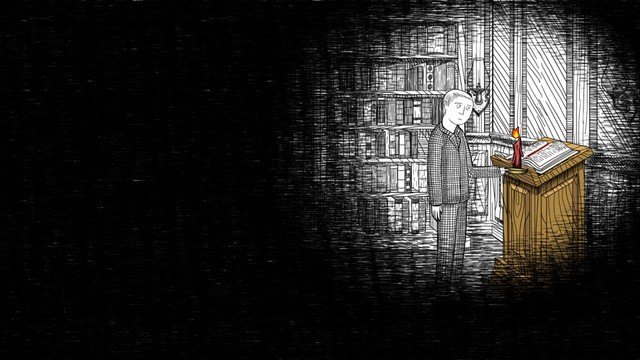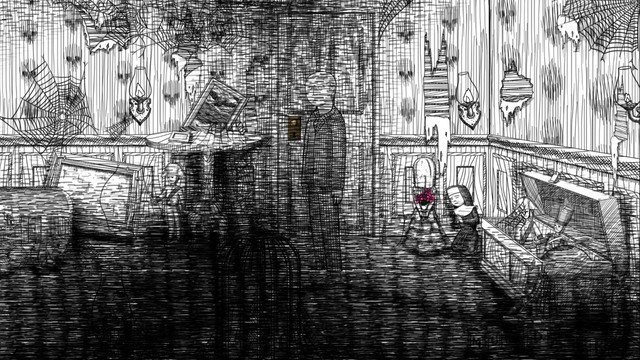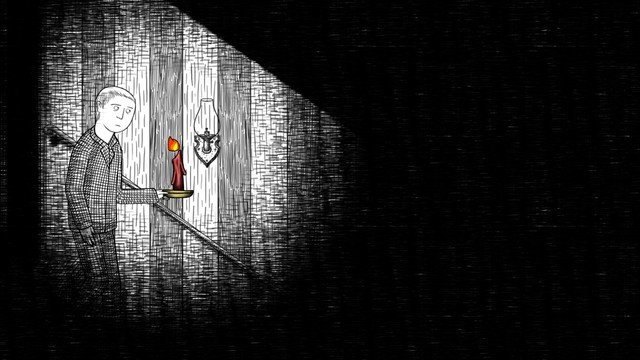When I was a kid, I had a recurring nightmare that I would wake from my bed, walk down the hall, and get killed by Jason Voorhees from Friday the 13th. After he stabbed or chainsawed me, I would wake up in bed and walk down the dark hallway to my death, only to wake up in my bed again. This dream would loop several times until I woke up in my room, not completely sure if I was dreaming or not.
That experience was what I was expecting from Neverending Nightmares, but it’s not exactly what I got. Instead of the torturous inevitability of death, I felt more that death was pretty avoidable. Some of the enemies didn’t even have eyeballs. While this was creepy, it made them far less threatening.
Origins
Neverending Nightmares started as a modestly successful Kickstarter. The project funded $106,722 out of a $99,000 goal. After the failure of his first “rhythm-up” game, Retro/Grade, creator Matt Gilgenbach decided instead to tread into some very dark, very personal territory.
It has definitely been therapeutic for me because I feel like I am able to sort of open up my head and let some of the negative, horrible thoughts out. Making them tangible causes them to lose their mystique and power–their grasp over me.
For Gilgenbach, who suffers from OCD and depression, the game became a conduit for his feelings isolation and desire to self-harm.
Themes
Arguably, the strongest part of this game is how it tells its story through motifs. In one of the first rooms, the main character Thomas encounters a Bible with a passage written in Latin. From then on, there is the repeating quote, “My God, why have you forsaken me?”
Everything that is colorful or lit up is important, which helps the player explore this disorienting landscape.
Later in the game, some of the home and asylum designs of previous levels clash together. Mixing these motifs is a clever way of suggesting that Thomas can no longer differentiate between his own home and the feeling of being trapped in an asylum.
Visual/audio
The art style is meant to simulate dreams. Crosshatching obscures the player’s vision, giving a sense of claustrophobia. The lack of color, also dreamlike, both gives a jarring contrast to the red blood and allows the player to easily pick up on what they can interact with.
The animation is deliberate, as Thomas cannot move fast and tires easily. His tiptoeing animation looks tedious, like the kind of steps you take when trying not to make the floorboards creak late at night. The juxtaposition of this slow buildup with the sudden violence of the deaths in the game really makes them stand out when they do happen.
You had better have a good pair of headphones when playing this game, because you need to know which direction the audio is coming from. I tried playing for a few minutes without headphones, just to see what it was like, and it was mostly me shouting, “Which direction is that sound coming from? I know it’s getting louder but I don’t know where it is!”
I guess you could try playing without the headphones as a sort of self-imposed “hard mode.” But even the game suggests headphones before playing; not having them does detract from the experience.
Gameplay
The game teaches you how to play, so most deaths are avoidable and not unfair. For instance, the first time you step on glass, it makes a loud noise and causes your foot to bleed to show you the mechanic. Any time after that, stepping on glass will get you killed fast. Each area follows different mechanics, so be prepared to learn as you go.
A lot of this game is tiptoeing around, exploring, and building up tension. The penalties for holding down the run button are fairly steep. You make a lot of noise panting and will eventually have to stop to recover your breath. This forces players to move slowly throughout the game.
The pacing is such that there is always a buildup to the scares. This is a good tactic to make jumpscares more scary, but the long walking section followed by a jump scare at the end starts to feel routine.
Personally, I wish there was more of a rug-pull early in the game where you die right away instead of trudging through the area for several minutes first.
There is not a huge variety of monsters, so it’s easy to treat them as very unscary “mobs” after encountering one or two iterations. The more you die, the less scary the monsters become.
It seems that Infinitap Games stayed a little too close to normal gaming conventions, when horror games should instead find ways to break those conventions to create fear and uncertainty in seasoned gamers.
Conclusion
Neverending Nightmares tows the line between being a disturbing exploration game like Yume Nikki and being a disturbing puzzle/adventure game like Limbo. At times it feels balanced, but then does a little too much or goes a little too far. This is a beautiful game, but moving from room to room and avoiding an increasingly large horde of monsters goes from feeling oppressive and scary to feeling like a slog.
If you’re a fan of horror games, I strongly suggest you pick it up. If not, this game may only be interesting to us literary and psychology nerds who enjoy analyzing a narrative largely implied by motifs and images.












Published: Oct 31, 2015 05:07 pm